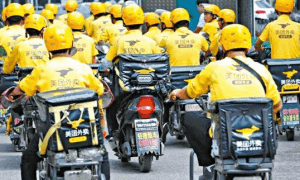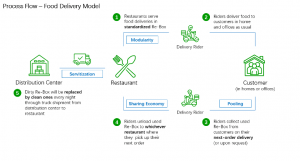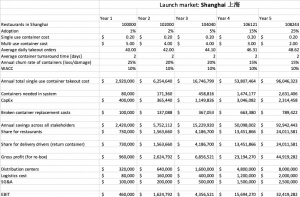convenience, consumption, confusion?
Don’t worry: Just Re-Box!
Takeaway food ordering and home delivery is on the rise, especially in Asia. What is often painted as the pinnacle of urban lifestyle and perceived as an affordable and convenient way to live life inadvertently leads to the destruction of our environment.
We at Re-Box have designed a circular, modular system that eliminates plastic waste from hospitality services and on top saves the restaurants money. All on the quest to be a “force for good”.

Idea & Motivation: Make every booming new business sustainable
Re-Box project is a business solution set to encourage the recycling of food delivery boxes in order to reduce the usage of single-use plastic packaging. Food delivery via online ordering platform has been booming in the previous decade in China, with a growth rate of 50.69% CAGR from 2015 to 2019. The total transaction amount reached to ¥461.3bn ($65.2bn) in 2019 in China. And it is one of most disruptive online new business models in this decade in China.
However, with the rapid g rowing market in food delivery, it is generating over 2 million tons of packaging waste each year, of which 70% are made of polypropylene plastics, a material with limited recycling value and has to be landfilled or incinerated, posing an enormous threat to public health and global ecosystem. Unproper treatment of used plastic has become a big threat to agriculture and marine ecology.
rowing market in food delivery, it is generating over 2 million tons of packaging waste each year, of which 70% are made of polypropylene plastics, a material with limited recycling value and has to be landfilled or incinerated, posing an enormous threat to public health and global ecosystem. Unproper treatment of used plastic has become a big threat to agriculture and marine ecology.
There are increasing concerns over the usage of single-use plastic packaging, and as the future leaders of business and who possess the belief of business as a force of good, we are passionate to make every booming new business model sustainable both financially and environmentally. With the government and public in China are becoming increasingly wary of this issue and urge businesses to take actions, we are confident this business model to recycle and reuse food delivery packaging would be a promising solution to reduce plastic usage, aiming to bring economic, social and environmental benefits to the society.
A solution to fill the gap between business and environment goals
Since the industry revolution, the development of human society has been, to some extent, at the expense of environment, business has been running mainly on the financial goals, neglecting its impact on sustainability. With the increasing public awareness and concerns over sustainability as well as more government policies and regulations, environment has become an important factor in corporate strategy.
Making every business sustainable is a long-term perspective but reducing the usage of plastic is an urgent need for our environment. On 19th January 2020, the National Development and Reform Commission and the Ministry of Ecology and Environment of China have jointly issued ‘opinions on further Strengthening the treatment of plastic Pollution’, also known as the “new plastic limit Order”, which clearly sets three time nodes of 2020, 2022 and 2025 to reduce plastic usage, including disposable plastic tableware, in China respectively.
It is an urgency for food delivery industry to come up with solutions to reach this goal with the public and the government. Our team’s Re-Box provides a feasible solution to, bring public awareness, educate public and small business owners, and bridge the gap between financial returns and environment targets with feasible financial benefits and positive environmental impacts.
Our value proposition and goals
We aim to become the first and foremost food container recycling business in China, that bridges restaurants, food delivery platforms and customers, and provides an integrated, financially and technologically feasible, solution to distribute, cleanse and reuse lunchboxes and cutleries, in order to increase public awareness, educate small business owners, encourage large corporate ESG responsibilities, and align with government and UN development goals to reduce the non-decomposable plastic usage.
In a short and mid-term, we aim to reduce and eliminate the food delivery plastic packaging usage in 5 years, align with China’s new plastic limit order; in a long term, we hope to look into solutions to reduce the usage of plastic in other aspects, e.g. plastic bags, etc. As a business, we also target to have financial returns. In a short term, we aim to sustain financially to grab the market and become the leader in recyclable container in China, and in a long term we aim to make more profits through product sales, operation optimization, economy of scale, as well as advertising and big-data revenues.
Our commitment to United Nations Sustainable Development Goals
 Through increasing public awareness, educating on sustainable usage of plastic products, reducing plastic food packaging waste, we aim to help achieve the United Nations Sustainable Development Goal 12 – Responsible Consumption and Production: to ensure that current material needs do not lead to the over-extraction of resources or to the degradation of environmental resources, and should include policies that improve resource efficiency, reduce waste and mainstream sustainability practices across all sectors of the economy.
Through increasing public awareness, educating on sustainable usage of plastic products, reducing plastic food packaging waste, we aim to help achieve the United Nations Sustainable Development Goal 12 – Responsible Consumption and Production: to ensure that current material needs do not lead to the over-extraction of resources or to the degradation of environmental resources, and should include policies that improve resource efficiency, reduce waste and mainstream sustainability practices across all sectors of the economy.
This project aims to achieve the followings (but not limited to) UN SDG indicators:
- 2.1 Material footprint, material footprint per capita, and material footprint per GDP
- 2.2 Domestic material consumption, domestic material consumption per capita, and domestic material consumption per GDP
- 4.1 Number of parties to international multilateral environmental agreements on hazardous waste, and other chemicals that meet their commitments and obligations in transmitting information as required by each relevant agreement
- 4.2 (a) Hazardous waste generated per capita; and (b) proportion of hazardous waste treated, by type of treatment
- 5.1 National recycling rate, tons of material recycled
- 8.1 Extent to which (i) global citizenship education and (ii) education for sustainable development are mainstreamed in (a) national education policies; (b) curricula; (c) teacher education; and (d) student assessment
- 1.1 (a) Index of coastal eutrophication; and (b) plastic debris density

Business model
We target an S-curve shaped adoption with a target adoption of 25% within 5 years. Through every dollar saved in single use plastic, we are able to give 25 cents to our partnering restaurants, 25 cents to our partnering drivers and even save the client money through offering bonus points or monetary discounts. Using pooling and demand forecasting methods, we are able to deliver timely and reliable service with lean operations by vertically integrating cleaning and redistribution of boxes. This leads to a cashflow positive business from year 1 and creates value for all stakeholders.




How can Re-Box achieve its sustainability and financial goals?
For Re-Box, profit model is split into two distinct phases to in order to achieve both sustainability and financial goals. During the first phase for first five years, Re-Box aims to become the provider of disposable plastic containers and cutleries by partnering with leading Chinese food delivery platforms such as Meituan, Ele.me etc. in Shanghai. By boosting customers’ awareness, Re-Box targets to change the throwaway culture to a reusable one in this phase by setting an incentive option for users on food delivery platforms. Reward points for being green are offered to incentivize environmentally aware consumers to make a personal effort to reduce plastic pollution. As Re-Box is targeting white collars, students and Gen Z who easily gravitate toward new trends, we are confident to command a gross profit of $45m at the end of this phase. From the restaurant side, it will cost them more to buy enhanced PP products containers than one-time single use plastic products, but that they can still save $730k if feeding into one year time frame (for the first year) and country’s food industry is obliged to take on this financial burden in order to protect their own environment. Re-Box will work with food delivery platforms to build up a rewarding system to authorize “green certificate” to restaurants proactively transforming into our reusable and standardized PP containers and cutleries. Correspondingly, restaurants with “green certificate” will earn more resources from food delivery platforms, which in turn, will promote more customers to look towards environmentally friendly restaurants by ads and recommendations.
With a customer base built up, there will be strong traction for Re-Box to achieve its financial goal by expanding both channels and product offering. Therefore, for the second phase, Re-Box will provide an integrated solution through not only food delivery platforms but also offline Convenience store chains and bento producers, penetrating more T1 and T2 cities and increasing touch points with more customers. With increased awareness boosted from the first phase, Re-Box will focus on interfacing with more businesses and various channels to achieve the economy of scale to afford us build the end-to-end and hassle-free service for both customers with integrated recycling solution including collecting, cleansing, sterilizing, dispatching and distributing. The efficient process flow can be achieved by advanced route planning analytics for delivery riders to collect the used containers and cutleries and transit to our warehouse for further processing. Moreover, the high volumes of customer data generated from the this closed-loop ecosystem will bring more revenue streams of customer insights and ads.
There is not only revenue growth facilitates Re-Box to achieve the financial goal of a profit margin of more than 40% in five years but also cost efficiency. To realise quick adoption and scale up, modularity takes a majority stake in value from the first phase. Through standardised container and cutlery designs, modularity benefits span the entire supply chain from design to sell the products, reducing complexity in both sourcing and quality control of the products. With customer-centric value proposition, Re-Box will procure sealable, resistant and harmless standardised containers and cutleries to create value for the customers through a hybrid of convenient recycling service and high quality products, Moreover, in order to ensure sufficient volume of containers and cutleries, Re-Box can build long-term relationship with suppliers to negotiate bulk purchasing at better price and consistent quality. Apart from supply chain management, Re-Box can achieve cost efficiency by gradually mitigating the incentives for consumer in the second phase when they already adopted the reusable culture in the previous phase.

How to address the key risks and challenges faced by Re-Box?
There are several downsides of Re-Box business model: Firstly, how Re-Box can prevent theft and abuse of our products? To avoid issues such as indiscriminate disposal and theft by customers, Re-Box will ensure all the containers and cutleries include Re-Box labels and charge a penalty fee if they are not confirmed to be returned on the platform. The most important response to this is the relentless focus on training the awareness of a recycling culture and sustainable society. This encourages responsible participation by the customers. Secondly, how Re-Box can build an efficient network to deliver and collect the containers and cutleries? Re-Box will work with food delivery platform to optimise the route for delivery riders to collect the used containers and cutleries. Customers can select to give back for their next order or “ready to collect” option on the platform so that delivery riders can collect at their earliest convenience. As delivery platforms in China are not restricting themselves to be just food delivery companies, but instead being all-encompassing lifestyle platforms connecting consumers to broader service providers. This will provide a more efficient route planning and benefit customers with safer food and more convenient return. Thirdly, how Re-Box can achieve higher scalability among its customers? Re-Box will secure long-term relationship with established restaurants and offline convenience store chains to gain customers faster to close the loop. We will implement our idea from population densely populated areas with higher sustainability participation willingness and expand to wider range of population with convenient delivery model and high quality.
Scaling up the business
As previously mentioned, our standardized product designs bring modularity to the entire supply chain. The modularity not only makes Re-Box more cost efficient, but also enables a quicker scaling up of the business.
On the other hand, our partners already have millions of merchants existing on their online platforms, covering various cities and areas. Our plan is to gradually improve adoption rate of consumers and to persuade these restaurants to include our products in their packaging options. By cooperating with more merchants, Re-Box will be able to achieve economies of scale that allow the business to enter the second phase of its planned development.
In the long run, the same partnership mode could also be introduced to new markets and new consumers. For instance, Re-Box could potentially partner with airlines and provide reusable packaging for in-flight meals.
However, there is one major barrier for scaling, which is the growth rate of awareness level and adoption by both restaurants and consumers. As mentioned, our business model has some inherent risks such as customers’ abusing and stealing boxes, and delivery guys’ accountability and efficiency. Although we’ve already designed corresponding rewards and penalty systems to control these risks, the associated expenses would cause extra financial burden on the business. To compensate for those expenses and further expand our business, general public’s awareness of recycling plays an important role.
To overcome the barrier, Re-box will continue to post ads and launch marketing campaigns to remind and educate customers. At the same time, we will further explore methods to drive down manufacturing costs of products and thus reducing unit price to restaurants. The reducing price would potentially incentivise merchants that were not eco-aware to partner with us.
Viability Experiment
We will partner with 5-10 small restaurants in one neighbourhood to run a viability experiment for a month. The neighbourhood should be within the delivery area by our potential platform partner. But instead of reaching out to the platform, we will provide our own delivery people to save negotiation time and commission fee.
Because our target customers in this experiment are mostly residents in this neighbourhood, it would be easy for us to monitor and fine-tune our delivery and collection process. We can further improve our prediction model for packaging demand and design a more accurate inventory management system. Based on the one-month data and feedbacks received, we will then get information on the feasibility of our business.
Next Steps
To launch the project, the immediate next step is to negotiate and build partnerships with food delivery platforms. The effectiveness of our business model largely depends on the existing food delivery system. We aim to leverage the scope and impact of those platforms to convince more restaurants to use our products, and to ultimately accelerate the scale-up process of our business.
We would utilize the result from viability experiment and the increasing social awareness of reducing waste to navigate our discussions with those platforms. We would also seek rapport from government and NGOs for their guidance on industry expectations and to further showcase Re-box’s commitment to sustainability.
After building initial partnerships with delivery platforms, we are open to rounds of pilot experiments in selected regions. For instance, we can start from a few districts in a tier-1 city. Information collected in those pilots will then be analyzed and reflected in the decisions of broadening product range and/or adding new distribution channels for the future.
Authors: (INSEAD 20J)
Lucas Zhou
Li Zhou
Joy Yin
Sean Xie
Benjamin Ding
